Lenovo Yoga 720 W Coreã¢â€žâ¢ I78550u Processor Review
Lenovo Yoga 730-13IKB (i7-8550U, 4K) Convertible Review
Ambitious middle-class Yoga. Good quality at a depression price - impossible? Lenovo attempts to fulfill this promise by releasing a heart-class convertible laptop playing in the upper league. You lot can read in this detailed review if this concept adds upwardly.

When people hear the give-and-take Yoga, they first remember almost twisted bodies. Nevertheless, the estimator manufacturer Lenovo succeeded to establish the term as a well-known brand name. Yoga is not as important as the brand "ThinkPad", but since the announcement of the first IdeaPad Yoga in 2012, information technology is probably Lenovo'due south 2d about important calculator brand. The manufacturer removed the characterization IdeaPad from their consumer models years agone and so that Yoga now appears as a single brand name. For their business models, however, they combined the powerful names "ThinkPad", "Yoga", and "X1" in a single device (ThinkPad X1 Yoga).
Today'southward review unit of measurement is not as high-priced equally the ThinkPad X1 Yoga. It is not even the flagship of the Yoga series for consumers, which is the Lenovo Yoga 920. The Lenovo Yoga 730-13IKB takes a dorsum seat. It is made for customers, who desire to buy a premium Yoga convertible merely do not desire to pay the cost for the absolute flagship model. The nomenclature for that thing is "upper eye class" rather than "upper class". Nosotros are testing the most expensive configuration of the Yoga 730-13IKB featuring the Intel Cadre i7-8550U, a 512 GB SSD, 16 GB of RAM, and a 4K (3,840 x ii,160) brandish at a i,399 Euro price point (~ $1,640). The Lenovo Yoga 920 would cost 300 Euros (~ $350) more with a comparable configuration but just 8 GB of RAM.
The Lenovo Yoga 730-13IKB competes against top-class devices such every bit the HP Spectre x360, the Dell XPS 13 ii-in-1, and the Lenovo Yoga 920.
Retention
16384 MB
, Soldered memory
Display
xiii.30 inch 16:9, 3840 x 2160 pixel 331 PPI, can find 10 fingers, native pen support, B133ZAN02.three, IPS LED, glossy: aye
Mainboard
Intel Kaby Lake-U + iHDCP 2.ii Premium PCH
Storage
SK Hynix PC401 512GB M.2 (HFS512GD9TNG), 512 GB
, M.ii 2280, PCIe NVMe SSD, 421 GB free
Weight
i.223 kg ( = 43.14 oz / 2.7 pounds), Power Supply: 356 g ( = 12.56 oz / 0.78 pounds)
Note: The manufacturer may use components from dissimilar suppliers including display panels, drives or retentiveness sticks with like specifications.
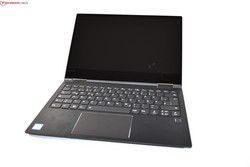
The Lenovo Yoga 730-13IKB is an update of the predecessor Lenovo Yoga 720-13IKB. This means that the general assembly is almost identical. Notwithstanding, Lenovo made some pocket-size modifications on the outside as well as on the within. The outside of the Yoga 730-13IKB received a facelift. The milled chrome edges, for instance, are gone making the design more than understated. Only the fingerprint reader and the TrackPad still take the chrome bezels, and the large Yoga logo on the display lid is chrome-plated. There are new color options available: dark gray, argent, and copper instead of gold, gray, and silvery. Our review unit has a night grayness case. Lenovo changed the design of the rear border of the laptop where the hinges are. Now, it is significantly more rounded and looks even more similar the HP Spectre x360 13. Some other minor change is the fan outlet blueprint. On the bottom of the laptop are two small rubber feet on the front and one long rubber foot at the back, instead of a small rubber foot in each corner.
Apart from the removal of chrome elements and the different color options, Lenovo has not changed the materials of the case. The unabridged case is made from aluminum, except for the drinking glass bezels around the display. Over all, the Lenovo Yoga 730-13IKB impresses with its high quality case and build quality. You can hardly warp or button in the base unit, and the display hat is relatively sturdy, thank you to the combination of metallic and glass, which covers the brandish panel.
Therefore, the Lenovo Yoga 730-13IKB is not extremely far from the more expensive Lenovo Yoga 920, merely at that place is 1 significant difference: The Yoga 730 has a conventional hinge blueprint with two hinges, whereas the Yoga 920 features the luxurious "watchband" hinge. Both designs let turning the display by 360 degrees for the tablet way. The hinges of the Yoga 730 allow more wobbling than the hinge of the Yoga 920. It is not possible to open the display lid with one hand.
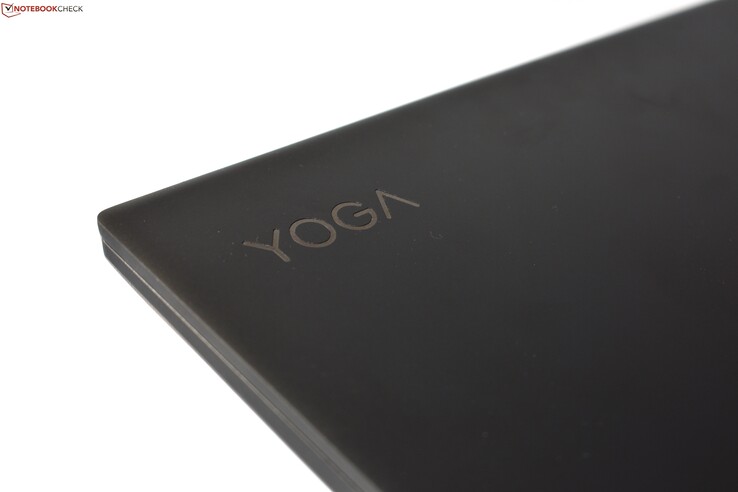
Together with theDell XPS 13 2-in-one, the Lenovo Yoga 730 is the lightest model in the line of competitors. TheLenovo Yoga 920 is significantly heavier past most 200 chiliad (~ 7oz), but it is also the largest convertible with its 13.nine-inch display. The other competitors have 13.3-inch displays. All the convertibles have very small bezels on the sides and on tiptop of the brandish but a large bezel beneath. This "chin" obstructs the otherwise elegant blueprint and wastes some real estate. Possibly information technology is fourth dimension for the manufacturers to switch to the three:2 aspect ratio for displays, like Huawei does with itsMateBook X Pro.
❌
Lenovo has barely changed the configuration of the ports compared to theYoga 720-13IKB. There are two USB Blazon-C ports and a headphone jack on the left side and a unmarried USB iii.0 Type-A port on the right side. The Yoga 730 does non feature an SD card reader or an HDMI port. More demanding users volition probably not be satisfied with this limited pick of ports.
The sole innovation hither is that both Type-C ports are supporting Thunderbolt 3 now, whereas the predecessor had simply i Thunderbolt 3 port. This ways virtually likely that the Thunderbolt 3 ports are connected via PCIe x4, because information technology is well-nigh ever the example for laptops with ii Thunderbolt 3 ports.
The merely communication module of the Lenovo Yoga 730-13IKB is the Wi-Fi module Intel Wireless 8265, which is a standard component for more expensive laptops. The operation is satisfactory during day-to-day utilize, merely the benchmarks showed a mixed result: The receiving performance is practiced, simply the sending performance is significantly below average.
The camera and the microphones are typical for laptops - the quality is simply sufficient for Skype video chats but non for more.
Consumer laptops usually do not come up with many security features. The fingerprint reader with touch applied science, which is integrated in the palm rest, is probably rather a convenience feature than a serious security characteristic. However, it works snappy and reliably in combination with Windows Hello.
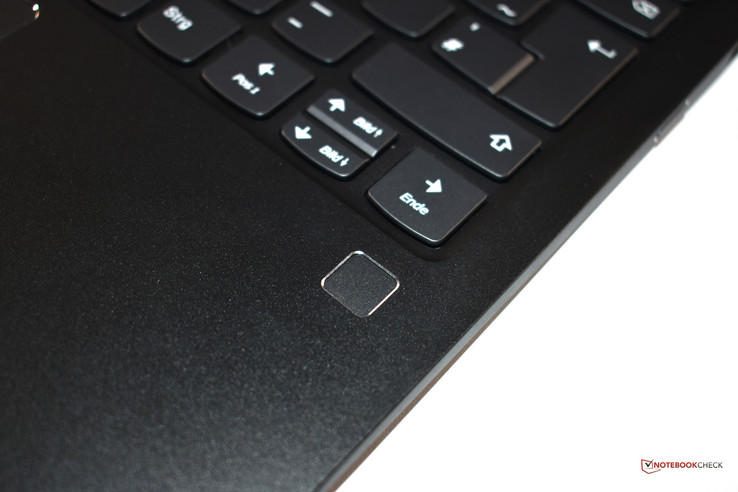
The Lenovo Yoga 730-13IKB comes with a 65-W power adapter as well as a digitizer pen, based on the Wacom AES technology. Therefore, the Yoga could be peculiarly interesting for students, who need a convertible for taking notes. Suitable batteries are also included. Nosotros volition have a deeper look at the pen in the section "input devices".
It is possible to access the interior of the Lenovo Yoga 730-13IKB past removing the nine Philips T5 screws, which are securing the bottom plate. After removing the bottom plate, you lot can admission of import components such as the battery, the ii minor fans, and the M.2 SSD. Yous tin can upgrade the SSD, only the master memory is soldered to the mainboard.
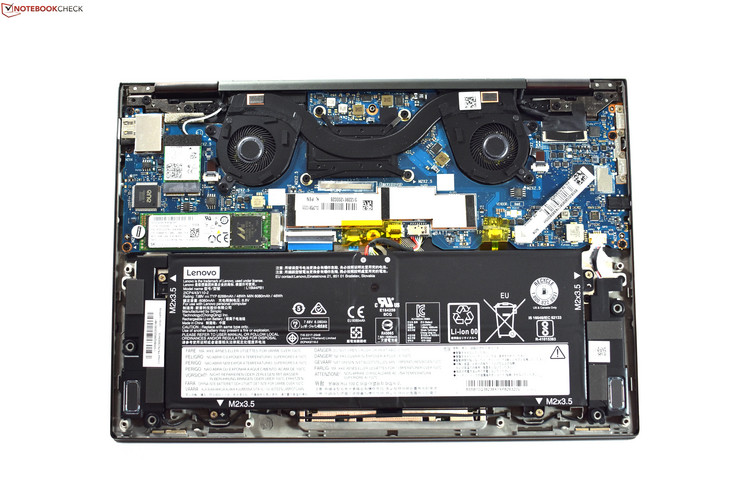
Keyboard
Lenovo equips its Yoga 730-13IKB with a chiclet keyboard with six rows of keys. The layout and design of the keys are still the same as for the predecessor. The bottom edges of the keys are slightly rounded, but the surface of the keys is apartment and not concave like the keys on a ThinkPad. The key travel is quite shallow, the pressure signal is not well divers, and the resistance is too small. Overall, the keyboard is usable only not really comfortable - in particular when compared to the ThinkPad keyboards.
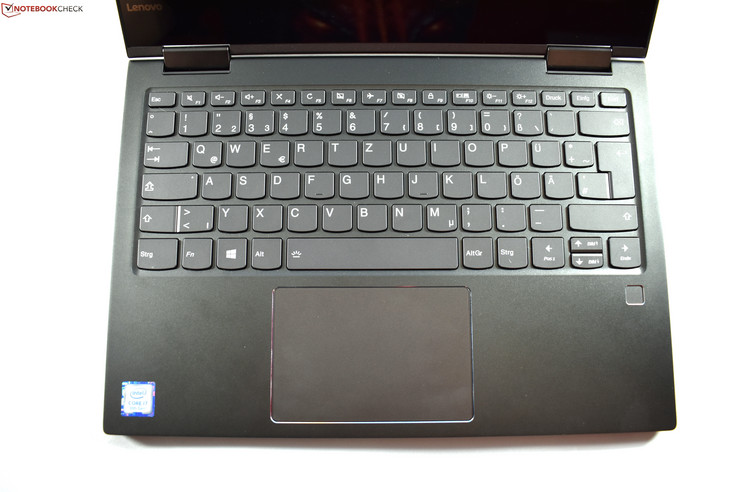
The TrackPad sits in the center of the palm residuum beneath the keyboard. The size of the TrackPad (10.v ten 7 cm, ~ four.1 x 2.8 inches) is advisable for a 13-inch laptop. There are no dedicated mouse keys, since the lower third of the TrackPad is clickable. The key travel of the TrackPad is short and crisp. The surface is very smooth and allows precise command of the mouse arrow - particularly in interaction with Microsoft's Precision Touchpad drivers. The TrackPad is definitely a practiced one.
You lot tin also use the touchscreen or the digitizer pen instead of the TrackPad. The touchscreen is able to detect ten fingers at the same time. It detects inputs very precisely. The pen is based on Wacom's AES technology and features 4,096 pressure stages. In our short test, it worked flawlessly even on the edges of the display. The pen has a comfortable grip and two buttons, whose functions can exist defined with the preinstalled Lenovo app. Past default, 1 button activates the eraser function.
Lenovo's spec sheet lists two display options for the Yoga laptop: a Full HD panel (ane,920 x 1,080) for the base model and a 4K panel (3,840 10 2,160). Both are IPS panels. The brandish is covered with glass, which makes it sleeky. Both display options have touch capability.
Today'due south review unit features the 4K console. Lenovo states a brightness value of 300 cd/yard². Nosotros measured an boilerplate maximum brightness of 299 cd/k², whichconfirms this specification. The competing convertibles have similar brightness values, fifty-fifty the Total HD display of the Yoga 730-13IKB, which has been tested by our U.S. editorial section. The contrast ratio of the 4K display, however, is twice as high as that of the Full Hard disk display. The HP Spectre x360 thirteen and the Dell XPS 13 2-in-1 are reaching similar dissimilarity ratios.
The display has neither PWM, nor a significant backlight bleeding. With 93%, the distribution of brightness is very consistent.
| 299 cd/m² | 299 cd/m² | 300 cd/m² | ||
| 295 cd/m² | 310 cd/yard² | 289 cd/m² | ||
| 292 cd/m² | 307 cd/one thousand² | 297 cd/thousand² | ||
Distribution of brightness
B133ZAN02.3
X-Rite i1Pro two
Maximum: 310 cd/thousand² (Nits) Boilerplate: 298.7 cd/m² Minimum: iii.vii cd/grand²
Effulgence Distribution: 93 %
Center on Bombardment: 311 cd/m²
Dissimilarity: 1550:one (Black: 0.2 cd/m²)
ΔE Color 4.ii | 0.59-29.43 Ø5.4, calibrated: 1.iv
ΔE Greyscale 6.2 | 0.64-98 Ø5.6
97.half-dozen% sRGB (Argyll ane.half dozen.3 3D)
62.eight% AdobeRGB 1998 (Argyll 1.6.3 3D)
68.three% AdobeRGB 1998 (Argyll ii.2.0 3D)
97.7% sRGB (Argyll 2.2.0 3D)
66.8% Brandish P3 (Argyll two.ii.0 3D)
Gamma: 2.1
| Lenovo Yoga 730-13IKB B133ZAN02.3, , 3840x2160, thirteen.30 | Lenovo Yoga 920-13IKB-80Y7 AU Optronics B139HAN03.0, , 1920x1080, thirteen.90 | Dell XPS 13-9365 2-in-1 1920x1080, thirteen.30 | Lenovo Yoga 730-13IKB-81CT LGD05B4 (LP133WF4-SPB8), , 1920x1080, xiii.30 | Lenovo Yoga 720-13IKB BOE CQ NV133FHM-N61, , 1920x1080, thirteen.30 | HP Spectre x360 13t-ae000 LGD0588, , 3840x2160, xiii.30 | HP Spectre x360 13-ae048ng Chi Mei (CMN1376), , 1920x1080, 13.thirty | |
|---|---|---|---|---|---|---|---|
| Display | -6% | -28% | -9% | -5% | 5% | 2% | |
| Display P3 Coverage | 66.8 | 62.5 -6% | 47.32 -29% | 65.6 -2% | 67.viii 1% | 71.ix 8% | 68.1 2% |
| sRGB Coverage | 97.vii | 91.7 -six% | 71.i -27% | 83.ix -14% | 88.2 -10% | 98.ane 0% | 99.v two% |
| AdobeRGB 1998 Coverage | 68.3 | 64.1 -6% | 48.83 -29% | 61.iv -10% | 64.four -6% | 73.1 7% | 70.2 3% |
| Response Times | 7% | 3% | 28% | -i% | 0% | 23% | |
| Response Time Greyness l% / Gray 80% * | 54 ? | 46 ? xv% | 48 ? xi% | 34 ? 37% | 48 ? 11% | 51.6 ? 4% | 36 ? 33% |
| Response Time Black / White * | 31.2 ? | 31.6 ? -1% | 32.viii ? -v% | 25.two ? xix% | 35 ? -12% | 32.four ? -iv% | 27 ? 13% |
| PWM Frequency | 1042 ? | 350 ? | 25000 ? | ||||
| Screen | -27% | -19% | -38% | -14% | xi% | -one% | |
| Brightness middle | 310 | 297.ix -4% | 322.6 4% | 301 -iii% | 297 -4% | 329.8 6% | 311 0% |
| Brightness | 299 | 278 -7% | 306 two% | 295 -1% | 277 -vii% | 318 6% | 278 -seven% |
| Brightness Distribution | 93 | 81 -xiii% | 91 -two% | 91 -2% | 87 -six% | 74 -20% | 82 -12% |
| Black Level * | 0.2 | 0.44 -120% | 0.19 5% | 0.36 -80% | 0.33 -65% | 0.25 -25% | 0.2 -0% |
| Contrast | 1550 | 677 -56% | 1698 10% | 836 -46% | 900 -42% | 1319 -15% | 1555 0% |
| Colorchecker dE 2000 * | 4.ii | five.i -21% | vii.7 -83% | 6.02 -43% | iv.93 -17% | two.37 44% | 3.98 five% |
| Colorchecker dE 2000 max. * | 8 | 11 -38% | 11.1 -39% | 11.36 -42% | 8.39 -five% | 4.08 49% | eight.48 -6% |
| Colorchecker dE 2000 calibrated * | one.iv | 4.74 -239% | |||||
| Greyscale dE 2000 * | vi.2 | half-dozen.seven -eight% | vii.9 -27% | 2.9 53% | four.84 22% | 2.8 55% | 5.57 ten% |
| Gamma | 2.ane 105% | ii.nine 76% | 2.88 76% | 1.96 112% | ii.5 88% | ii.145 103% | 2.51 88% |
| CCT | 6983 93% | 6839 95% | 7044 92% | 6408 101% | 6894 94% | 6441 101% | 7810 83% |
| Color Space (Percent of AdobeRGB 1998) | 62.viii | 64.1 2% | 44.1 -30% | 61.38 -2% | 58 -8% | 67 seven% | 64 2% |
| Color Space (Percent of sRGB) | 97.vi | 91.7 -6% | 69.9 -28% | 83.92 -14% | 88 -10% | 98 0% | 99 1% |
| Total Boilerplate (Plan / Settings) | -9% / -18% | -15% / -eighteen% | -half-dozen% / -24% | -7% / -11% | 5% / 8% | 8% / 3% |
* ... smaller is improve
Out of the box, the display has a noticeable green color cast, which can be eliminated past calibration. As e'er, we are providing the ICC profile for this purpose. Overall, the subjective impression of the calibrated display is very good. Thanks to the high contrast ratio, black does non look like dark grayness.
With a coverage of 97% sRGB, the colour gamut contributes to the good impression. This is a decent value that nosotros expect from a device in this price range. You should exist able to do some semi-professional image editing. However, the 4K LCD of the Yoga 730-13IKB is not a wide-gamut brandish. For this, information technology would take to encompass more than than 62% of the AdobeRGB color space.
Unfortunately, the display is non suitable for outdoor utilize even though the maximum brightness is 300 cd/one thousand². Due to the sleeky surface, we noticed plenty of disturbing reflections even in the shadow. The display is not bright plenty to outshine these reflections.
Display Response Times
ℹ
Display response times bear witness how fast the screen is able to modify from 1 color to the side by side. Slow response times can atomic number 82 to afterimages and can cause moving objects to announced blurry (ghosting). Gamers of fast-paced 3D titles should pay special attention to fast response times.
| ↔ Response Fourth dimension Black to White | ||
|---|---|---|
| 31.ii ms ... rise ↗ and fall ↘ combined | ↗ xvi.four ms rise | 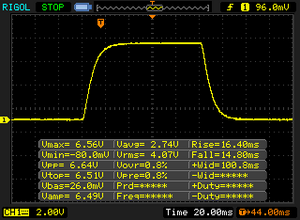 |
| ↘ 14.8 ms fall | ||
| The screen shows slow response rates in our tests and volition exist unsatisfactory for gamers. In comparison, all tested devices range from 0.8 (minimum) to 240 (maximum) ms. » 79 % of all devices are better. This means that the measured response time is worse than the average of all tested devices (23.5 ms). | ||
| ↔ Response Time l% Grey to eighty% Grey | ||
| 54 ms ... rising ↗ and fall ↘ combined | ↗ 24.4 ms rise | 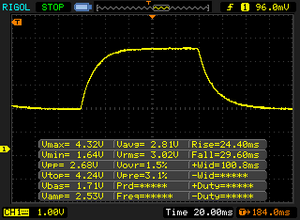 |
| ↘ 29.half-dozen ms fall | ||
| The screen shows irksome response rates in our tests and will be unsatisfactory for gamers. In comparing, all tested devices range from 0.692 (minimum) to 636 (maximum) ms. » 88 % of all devices are ameliorate. This ways that the measured response fourth dimension is worse than the average of all tested devices (37.i ms). | ||
Screen Flickering / PWM (Pulse-Width Modulation)
ℹ
To dim the screen, some notebooks will simply cycle the backlight on and off in rapid succession - a method chosen Pulse Width Modulation (PWM) . This cycling frequency should ideally be undetectable to the human eye. If said frequency is too low, users with sensitive eyes may experience strain or headaches or even detect the flickering altogether.
| Screen flickering / PWM not detected | 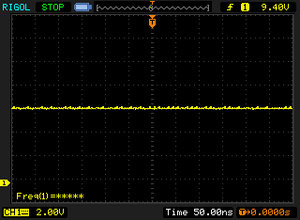 | ||
| In comparing: 52 % of all tested devices practice non employ PWM to dim the brandish. If PWM was detected, an boilerplate of 22039 (minimum: 5 - maximum: 3846000) Hz was measured. | |||
The viewing bending stability is very good, which is typical for IPS displays.

As of now (end of July 2018), in that location are six different models of the Lenovo Yoga 730-13IKB available in the United States. Two models (81CT0023GE & 81CT008EGE) are almost identical. The base model, which currently costs 999 Euros (~ $1,170), is available in dark grayness or silver. Both colors are equipped with the aforementioned hardware components (Core i5-8250U, 8 GB RAM, 256 GB SSD, Full Hd brandish). The more expensive configuration 81CT0080GE is exclusively available in the Lenovo online store. This one features an Intel Core i7-8550U CPU, 8 GB of RAM, a Full HD display, and a 512 GB SSD. The color of the case is silverish. The remaining iii models are equipped with 16 GB of DDR4-2400 RAM (which is soldered to the mainboard) and aCore i7-8550U CPU. The cheaper configuration of the three has a 256 GB SSD; the other 2 have a 512 GB SSD. Only the most expensive model, which is our review unit, features a 4K brandish.
Intel'sCore i7-8550U is an ultra-low voltage (ULV) processor with 4 cores. It has a thermal pattern power (TDP) of 15 Westward. The clock speed ranges between i.8 and iv GHz (Turbo Heave). You tin compare the CPU with other processors in ourCPU benchmark table.
Lenovo allows the CPU to have a significantly higher maximum power consumption of 33 Westward - but only for 30 seconds. This results in a skilful boost operation, however, the temperature jumps up to 97 °C (~ 207 °F). Therefore, the clock speed drops apace from 3.1 GHz to ii.nine GHz. For a short time, the power consumption lies at 28 W. Even this performance cannot be delivered permanently. In the long run, the clock speed evens out at two.2 GHz with a power limit of xiv W. This explains the relatively quick decline of functioning in the Cinebench loop.
Cinebench R15 CPU Multi 64 Chip
Thanks to the good heave operation, the Yoga 730-13IKB takes the atomic number 82 in our CPU benchmark tabular array. In the end, however, theLenovo Yoga 920-13IKB delivers a ameliorate performance, whereas theHP Spectre x360 offers roughly the aforementioned functioning under load every bit the Yoga 730. At to the lowest degree, the Yoga 730-13IKB is faster than its predecessorYoga 720-13IKB. This one had the aforementioned processor, but Lenovo re-engineered the cooling arrangement, which is probably the reason for the better CPU performance of the newer model.
The CPU operation is throttled during battery performance. Here, the Yoga 730 reaches only 530 points instead of 630 in the Cinebench multi-core examination.
Cinebench R15 OpenGL 64Bit
53.7 fps
Cinebench R15 Ref. Match 64Bit
97.eight %
Cinebench R15 CPU Multi 64Bit
630 Points
Cinebench R15 CPU Unmarried 64Bit
163 Points
Help
The organisation performance of the Yoga 730-13IKB is proficient, even though the PCMark results are slightly lower than those of the competitors. The lower results are probably mainly caused past the higher display resolution. During mean solar day-to-day use, however, the system was always running smoothly.
| PCMark 8 | |
| Home Score Accelerated v2 | |
| Lenovo Yoga 920-13IKB-80Y7 | |
| Lenovo Yoga 730-13IKB-81CT | |
| Average of grade Convertible (1670 - 5041, n=31, last 2 years) | |
| Lenovo Yoga 720-13IKB | |
| Average Intel Cadre i7-8550U, Intel UHD Graphics 620 (3024 - 4197, n=33) | |
| HP Spectre x360 xiii-ae048ng | |
| Lenovo Yoga 730-13IKB | |
| HP Spectre x360 13t-ae000 | |
| Dell XPS xiii-9365 2-in-i | |
| Work Score Accelerated v2 | |
| Lenovo Yoga 920-13IKB-80Y7 | |
| Lenovo Yoga 730-13IKB-81CT | |
| Lenovo Yoga 720-13IKB | |
| Dell XPS 13-9365 2-in-i | |
| Boilerplate Intel Core i7-8550U, Intel UHD Graphics 620 (3518 - 5154, n=27) | |
| HP Spectre x360 thirteen-ae048ng | |
| Lenovo Yoga 730-13IKB | |
| HP Spectre x360 13t-ae000 | |
| Average of course Convertible (2435 - 5273, northward=29, concluding 2 years) | |
| PCMark ten | |
| Digital Content Creation | |
| Boilerplate of class Convertible (886 - 6844, n=77, last 2 years) | |
| Lenovo Yoga 730-13IKB-81CT | |
| Lenovo Yoga 920-13IKB-80Y7 | |
| Lenovo Yoga 730-13IKB | |
| Average Intel Core i7-8550U, Intel UHD Graphics 620 (1506 - 3160, n=29) | |
| HP Spectre x360 13t-ae000 | |
| Lenovo Yoga 720-13IKB | |
| Productivity | |
| Lenovo Yoga 920-13IKB-80Y7 | |
| Lenovo Yoga 730-13IKB-81CT | |
| Average of form Convertible (2411 - 8860, n=77, last 2 years) | |
| Average Intel Core i7-8550U, Intel UHD Graphics 620 (4889 - 7006, n=29) | |
| Lenovo Yoga 730-13IKB | |
| Lenovo Yoga 720-13IKB | |
| HP Spectre x360 13t-ae000 | |
| Essentials | |
| Lenovo Yoga 730-13IKB-81CT | |
| Average of class Convertible (3602 - 11505, northward=77, concluding ii years) | |
| Lenovo Yoga 920-13IKB-80Y7 | |
| Lenovo Yoga 730-13IKB | |
| Average Intel Cadre i7-8550U, Intel UHD Graphics 620 (6628 - 9291, n=29) | |
| HP Spectre x360 13t-ae000 | |
| Lenovo Yoga 720-13IKB | |
| Score | |
| Average of form Convertible (1429 - 5971, n=77, last ii years) | |
| Lenovo Yoga 730-13IKB-81CT | |
| Lenovo Yoga 920-13IKB-80Y7 | |
| Lenovo Yoga 730-13IKB | |
| Average Intel Cadre i7-8550U, Intel UHD Graphics 620 (2629 - 4072, n=31) | |
| HP Spectre x360 13t-ae000 | |
| Lenovo Yoga 720-13IKB | |
| PCMark 8 Habitation Score Accelerated v2 | 3317 points | |
| PCMark eight Piece of work Score Accelerated v2 | 4177 points | |
| PCMark 10 Score | 3739 points | |
| Aid | ||
The Lenovo Yoga 730-13IKB features a unmarried G.2-2280 SSD. Our review unit has a PCIe-NVMe SSD with a capacity of 512 GB produced by Hynix. The model number is HFS512GD9TNG. The speed is satisfactory for a PCIe-NVMe SSD: It is faster than the often-used Toshiba XG5 but slower than the Samsung PM961.
| Lenovo Yoga 730-13IKB SK Hynix PC401 512GB M.2 (HFS512GD9TNG) | Lenovo Yoga 920-13IKB-80Y7 Samsung PM961 MZVLW256HEHP | Dell XPS 13-9365 2-in-1 Toshiba NVMe THNSN5256GPUK | Lenovo Yoga 730-13IKB-81CT Toshiba XG5 KXG50ZNV256G | Lenovo Yoga 720-13IKB Toshiba XG4 NVMe (THNSN5512GPUK) | HP Spectre x360 13-ae048ng Toshiba NVMe THNSN51T02DUK | Average SK Hynix PC401 512GB M.2 (HFS512GD9TNG) | |
|---|---|---|---|---|---|---|---|
| CrystalDiskMark 3.0 | 21% | -24% | -29% | -15% | -seven% | 7% | |
| Read Seq | 1861 | 2070 eleven% | 1206 -35% | 1975 6% | 1345 -28% | 919 -51% | 1748 ? -half-dozen% |
| Write Seq | 1128 | 1125 0% | 629 -44% | 322.8 -71% | 569 -50% | 776 -31% | 1088 ? -4% |
| Read 512 | 1364 | 1252 -viii% | 966 -29% | 775 -43% | 1041 -24% | 620 -55% | 1134 ? -17% |
| Write 512 | 657 | 832 27% | 410.vii -37% | 336.7 -49% | 547 -17% | 575 -12% | 918 ? 40% |
| Read 4k | 39.27 | 56.2 43% | 32.93 -xvi% | 7.04 -82% | 38.42 -ii% | 45.99 17% | 44.9 ? 14% |
| Write 4k | 143.4 | 142.4 -1% | 121.2 -15% | 132.v -8% | 127.i -11% | 138.1 -4% | 135.8 ? -5% |
| Read 4k QD32 | 370.half-dozen | 432.nine 17% | 411 11% | 395.8 7% | 416.four 12% | 542 46% | 427 ? 15% |
| Write 4k QD32 | 324.seven | 573 76% | 250.2 -23% | 348.3 7% | 337.5 4% | 437.3 35% | 386 ? 19% |
Sequential Read: 1861 MB/s
Sequential Write: 1128 MB/southward
4K QD32 Write: 324.7 MB/southward
CDM 5/6 Read Seq Q32T1: 2692 MB/s
CDM 5/6 Write Seq Q32T1: 944 MB/s
CDM five/6 Read 4K Q32T1: 316.9 MB/due south
CDM v/six Write 4K Q32T1: 286.seven MB/s
CDM five Read Seq: 1274 MB/s
CDM five Write Seq: 1282 MB/s
CDM 5/6 Read 4K: 42.83 MB/due south
CDM 5/6 Write 4K: 115.8 MB/s
CDM six Write 4K Q8T8: 746 MB/due south
CDM half-dozen Read 4K Q8T8: 715 MB/s
Sequential Read: 2334MB/s
Sequential Write: 872MB/s
Access Time Read: 0.045ms
Admission Time Write: 0.051ms
Intel's UHD Graphics 620 is the iGPU standard solution for most of the Ultrabooks in 2018. Its performance highly depends on the RAM configuration. Retentivity performance in single-channel manner adversely affects the performance of a GPU without dedicated memory. Fortunately, the soldered RAM in the Yoga 730-13IKB operates in dual-channel style, assuasive the GPU to max out its limited capability.
We were unable to observe a throttling of the GPU performance during battery operation.
| 3DMark 11 - 1280x720 Performance GPU | |
| Average of form Convertible (477 - 17421, n=82, last 2 years) | |
| Lenovo Yoga 730-13IKB-81CT | |
| Lenovo Yoga 720-13IKB | |
| Boilerplate Intel UHD Graphics 620 (1144 - 2006, n=241) | |
| Lenovo Yoga 920-13IKB-80Y7 | |
| Lenovo Yoga 730-13IKB | |
| HP Spectre x360 13t-ae000 | |
| HP Spectre x360 xiii-ae048ng | |
| Dell XPS thirteen-9365 2-in-1 | |
| 3DMark | |
| 1280x720 Cloud Gate Standard Graphics | |
| Average of class Convertible (2714 - 38321, n=70, final 2 years) | |
| Lenovo Yoga 730-13IKB-81CT | |
| Lenovo Yoga 920-13IKB-80Y7 | |
| Lenovo Yoga 730-13IKB | |
| Lenovo Yoga 720-13IKB | |
| Boilerplate Intel UHD Graphics 620 (6205 - 11437, n=222) | |
| HP Spectre x360 13-ae048ng | |
| HP Spectre x360 13t-ae000 | |
| Dell XPS 13-9365 ii-in-1 | |
| 1920x1080 Fire Strike Graphics | |
| Average of class Convertible (357 - 13158, due north=83, concluding two years) | |
| Lenovo Yoga 730-13IKB-81CT | |
| Lenovo Yoga 730-13IKB | |
| Boilerplate Intel UHD Graphics 620 (557 - 1444, n=210) | |
| Lenovo Yoga 920-13IKB-80Y7 | |
| Lenovo Yoga 720-13IKB | |
| HP Spectre x360 13t-ae000 | |
| HP Spectre x360 13-ae048ng | |
| Dell XPS xiii-9365 two-in-1 | |
| 3DMark eleven Performance | 1850 points | |
| 3DMark Cloud Gate Standard Score | 7806 points | |
| 3DMark Burn down Strike Score | 1061 points | |
| Help | ||
If you want to play games, you lot should look for a different laptop. Even though simple games from the Windows Store or older games are playable with low details, you will not be able to play newer games on the Lenovo Yoga 730-13IKB for the lack of a dedicated GPU.
The fan of the Yoga 730-13IKB generally remains off when idle. Under load, information technology is running continuously with 39.3 dB(A), which is clearly aural. Fortunately, the whirring does non take a high frequency so that it is non extremely disturbing. We were not able to notice whatsoever static.
Noise Level
| Idle | 29.seven / 29.vii / xxx.7 dB(A) | |
| Load | 39.iii / 39.3 dB(A) | |
 | ||
| xxx dB xl dB(A) fifty dB(A) | ||
| min: | ||

The surface temperatures are very low when idle. They are rising slightly under load, specially on the rear role of the case. We measured 46.2 °C (~ 115 °F) in the centre of the bottom, which is noticeably warm just still uncritical.
The stress test with FurMark and Prime95 reflects the results of the Cinebench loop: CPU and GPU together are allowed to swallow more 30 W for a short time, causing the internal temperatures to rise significantly. Withal, power consumption and clock speeds subtract just as speedily, and the CPU speed levels off at just 900 MHz afterwards two minutes. This indicates TDP and temperature-induced throttling. The 3DMark11, which we ran directly afterwards the stress examination, achieved a normal result. Hence, you should not feel throttling during twenty-four hours-to-twenty-four hours use.
| |||||||||||||||||||||||||
| Maximum: 38 °C = 100 F Average: 31.9 °C = 89 F | |||||||||||||||||||||||||
| |||||||||||||||||||||||||
| Maximum: 46.two °C = 115 F Average: 34.4 °C = 94 F | |||||||||||||||||||||||||
Power Supply (max.) 30.7 °C = 87 F | Room Temperature 23.7 °C = 75 F | Voltcraft IR-900
| |||||||||||||||||||||||||
| Maximum: 27.9 °C = 82 F Boilerplate: 27.1 °C = 81 F | |||||||||||||||||||||||||
| |||||||||||||||||||||||||
| Maximum: 28.6 °C = 83 F Boilerplate: 27.4 °C = 81 F | |||||||||||||||||||||||||
Ability Supply (max.) 26.7 °C = lxxx F | Room Temperature 23.5 °C = 74 F | Voltcraft IR-900
(+) The average temperature for the upper side under maximal load is 31.9 °C / 89 F, compared to the average of thirty.2 °C / 86 F for the devices in the class Convertible.
(+) The maximum temperature on the upper side is 38 °C / 100 F, compared to the average of 35.three °C / 96 F, ranging from 21 to 55.7 °C for the class Convertible.
(-) The bottom heats upward to a maximum of 46.2 °C / 115 F, compared to the average of 36.6 °C / 98 F
(+) In idle usage, the average temperature for the upper side is 27.1 °C / 81 F, compared to the device average of 30.two °C / 86 F.
(+) The palmrests and touchpad are libation than peel temperature with a maximum of 27.iii °C / 81.one F and are therefore cool to the impact.
(±) The boilerplate temperature of the palmrest area of like devices was 28.4 °C / 83.one F (+1.1 °C / 2 F).
The performance of the speakers is not satisfactory despite the preinstalled "Dolby Atmos" app. The sound is unbalanced, and the volume is quite low. For example, the speakers of theHP Spectre x360 13 are slightly better. You lot should rather employ external speakers or headphones instead of the Yoga's internal speakers. The combined headphone and microphone jack works perfectly.
Frequency diagram (checkboxes can be checked and unchecked to compare devices)
Lenovo Yoga 730-13IKB sound analysis
(±) | speaker loudness is average but good (77.9 dB)
Bass 100 - 315 Hz
(-) | nearly no bass - on average 22.9% lower than median
(±) | linearity of bass is average (13.iv% delta to prev. frequency)
Mids 400 - 2000 Hz
(+) | balanced mids - simply 4.2% away from median
(+) | mids are linear (5.8% delta to prev. frequency)
Highs two - sixteen kHz
(+) | counterbalanced highs - simply 2.9% abroad from median
(+) | highs are linear (5.iv% delta to prev. frequency)
Overall 100 - sixteen.000 Hz
(±) | linearity of overall sound is boilerplate (19.7% deviation to median)
Compared to aforementioned class
» 49% of all tested devices in this form were better, viii% similar, 42% worse
» The best had a delta of 6%, average was 20%, worst was 53%
Compared to all devices tested
» 47% of all tested devices were ameliorate, 8% like, 46% worse
» The best had a delta of 3%, average was 20%, worst was 65%
HP Spectre x360 thirteen-ae048ng audio assay
(±) | speaker loudness is boilerplate but adept (72.vi dB)
Bass 100 - 315 Hz
(±) | reduced bass - on average thirteen.4% lower than median
(+) | bass is linear (half dozen.3% delta to prev. frequency)
Mids 400 - 2000 Hz
(+) | balanced mids - only iv% away from median
(+) | mids are linear (four% delta to prev. frequency)
Highs 2 - 16 kHz
(+) | balanced highs - just 1.five% away from median
(+) | highs are linear (4% delta to prev. frequency)
Overall 100 - sixteen.000 Hz
(+) | overall sound is linear (11.5% difference to median)
Compared to same class
» 6% of all tested devices in this class were better, 2% like, 92% worse
» The best had a delta of 6%, boilerplate was twenty%, worst was 53%
Compared to all devices tested
» six% of all tested devices were meliorate, 2% similar, 92% worse
» The best had a delta of 3%, boilerplate was 20%, worst was 65%
The idle values of the Lenovo Yoga 730-13IKB are slightly college than those of the competitors. Interestingly, just the Yoga 730-13IKB that was tested by our U.South. editorial department was performing even worse. This model had a Full HD brandish; our review unit of measurement has a high-resolution 4K panel instead. It could exist possible that Lenovo has optimized the power consumption by firmware updates for the 4K model. The display of our review unit probably causes the majority of the higher power consumption when idle, compared to theLenovo Yoga 920-13IKB or theHP Spectre x360 thirteen.
The included 65-W ability supply is adequate for the maximum power consumption of 54 Due west.
| Lenovo Yoga 730-13IKB i5-8550U, UHD Graphics 620, SK Hynix PC401 512GB M.ii (HFS512GD9TNG), IPS LED, 3840x2160, 13.30 | Lenovo Yoga 920-13IKB-80Y7 i5-8550U, UHD Graphics 620, Samsung PM961 MZVLW256HEHP, IPS, 1920x1080, 13.xc | Dell XPS thirteen-9365 2-in-ane i7-7Y75, HD Graphics 615, Toshiba NVMe THNSN5256GPUK, IPS, 1920x1080, 13.30 | Lenovo Yoga 730-13IKB-81CT i5-8250U, UHD Graphics 620, Toshiba XG5 KXG50ZNV256G, IPS, 1920x1080, 13.30 | Lenovo Yoga 720-13IKB i5-8550U, UHD Graphics 620, Toshiba XG4 NVMe (THNSN5512GPUK), IPS, 1920x1080, thirteen.30 | HP Spectre x360 13t-ae000 i5-8550U, UHD Graphics 620, Lite-On CA1-8D256-HP, IPS, 3840x2160, 13.30 | HP Spectre x360 thirteen-ae048ng i5-8550U, UHD Graphics 620, Toshiba NVMe THNSN51T02DUK, IPS, 1920x1080, thirteen.xxx | Boilerplate Intel UHD Graphics 620 | Average of class Convertible | |
|---|---|---|---|---|---|---|---|---|---|
| Power Consumption | 27% | 47% | -34% | xiii% | -1% | 26% | 15% | 16% | |
| Idle Minimum * | 4.86 | 3.1 36% | 3.one 36% | 8.v -75% | 3.eight 22% | five.nine -21% | iii.2 34% | iii.79 ? 22% | three.84 ? 21% |
| Idle Boilerplate * | 7.56 | 6.vi xiii% | 4.3 43% | xi.viii -56% | 8.four -eleven% | 9.8 -thirty% | half dozen 21% | vi.96 ? viii% | 6.66 ? 12% |
| Idle Maximum * | ix.66 | 7 28% | 4.nine 49% | 13.1 -36% | nine.7 -0% | 10.6 -10% | 9.2 5% | 8.78 ? nine% | 8.39 ? thirteen% |
| Load Average * | 45.7 | 35.ii 23% | 24.3 47% | 51.1 -12% | 36 21% | 36.6 20% | 29.5 35% | 35.1 ? 23% | 33.ix ? 26% |
| Load Maximum * | 54 | 34.half-dozen 36% | 22.viii 58% | 49 9% | 36 33% | 34.3 36% | 35.vi 34% | 47.4 ? 12% | 49.three ? nine% |
* ... smaller is better
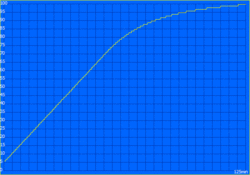
The Yoga 730-13IKB contains a lithium-ion bombardment with a chapters of 48 Wh, only like its predecessorYoga 720-13IKB. Information technology becomes clear at this point that this is not a high-terminate convertible: All the more expensive competitors are better equipped. TheHP Spectre x360 13, for instance, features a lx-Wh battery, theLenovo Yoga 920-13IKB fifty-fifty a lxx-Wh battery. Particularly in combination with the college power consumption, this leads to sobering results for the battery examination of the Yoga 730-13IKB: The laptop died after less than six hours in the Wi-Fi exam. With values ranging between ix and 11.5 hours, the competitors are clearly superior in this practical test.
The charging time is 125 minutes.
Bombardment Runtime
| Idle (without WLAN, min effulgence) | 11h 19min | |
| WiFi Websurfing (Edge) | 5h 50min | |
| Large Cadet Bunny H.264 1080p | 7h 31min | |
| Load (maximum brightness) | 1h 39min |
| Lenovo Yoga 730-13IKB i5-8550U, UHD Graphics 620, 48 Wh | Lenovo Yoga 920-13IKB-80Y7 i5-8550U, UHD Graphics 620, 70 Wh | Dell XPS 13-9365 2-in-1 i7-7Y75, HD Graphics 615, 46 Wh | Lenovo Yoga 730-13IKB-81CT i5-8250U, UHD Graphics 620, 48 Wh | Lenovo Yoga 720-13IKB i5-8550U, UHD Graphics 620, 48 Wh | HP Spectre x360 13t-ae000 i5-8550U, UHD Graphics 620, threescore Wh | HP Spectre x360 13-ae048ng i5-8550U, UHD Graphics 620, lx Wh | Boilerplate of form Convertible | |
|---|---|---|---|---|---|---|---|---|
| Battery Runtime | 94% | 72% | 30% | 33% | 22% | 85% | 61% | |
| Reader / Idle | 679 | 1655 144% | 971 43% | 901 33% | 1350 ? 99% | |||
| H.264 | 451 | 1070 137% | 616 ? 37% | |||||
| WiFi v1.3 | 350 | 685 96% | 686 96% | 565 61% | 466 33% | 424 21% | 527 51% | 578 ? 65% |
| Load | 99 | 140 41% | 175 77% | 96 -3% | 121 22% | 166 68% | 140.8 ? 42% |
Pros
+ Premium metal case
+ Hassle-free upgrade of SSD
+ 4K display with skilful color gamut & high contrast ratio
+ Comfortable trackpad
+ Included digitizer pen
+ Better CPU performance than the predecessor
Cons
- Limited connectivity
- Keyboard pressure point also soft
- No option for a brighter, outdoor-suitable display
- Speakers unsatisfactory
- Poor battery life
- CPU throttled during bombardment operation
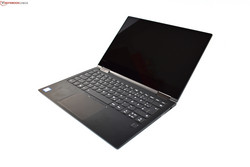
The Lenovo Yoga 730-13IKB is an interesting update of its predecessor. In some respects, the quality reaches that of the more expensive convertibles. In other cases, however, information technology is inferior.
Potent points of the Yoga 730-13IKB are the premium aluminum case and the relatively low weight. It is easy to maintain: Upgrading the SSD is simple, which is not common anymore for today's consumer laptops. The 4K display delivers the promised brightness, a good contrast ratio, and almost 100% of the sRGB color gamut. It does not have any issues with screen flickering or backlight haemorrhage. The laptop has a pretty expert TrackPad without any major weaknesses. Additionally, yous can operate the laptop using the touchscreen or the digitizer pen. It is dandy that the pen is included and does not demand to exist purchased separately. An comeback over the predecessor (Yoga 720-13IKB) is the ameliorate cooling system, which allows better boost performance as well as amend long-term performance.
The connectivity has been slightly improved: The laptop features two Thunderbolt 3 ports instead of 1. Over all, the connectivity remains very limited. Unlike the TrackPad, the quality of the keyboard is non appealing. The fact that Lenovo does not offer a brighter brandish selection is disappointing, because the sleeky surface makes outdoor performance near incommunicable. 300 cd/one thousand² are not bright enough for this purpose. Another signal of criticism is the depression performance of the speakers. The biggest flaw, yet, is the battery life, which is much worse than that of the competitors, due to higher power consumption (caused by the 4K brandish) and smaller battery capacity. Lastly, nosotros criticize the CPU throttling during battery operation.
Peculiarly cheaper configurations of the Lenovo Yoga 730-13IKB with Full Hard disk drive display offer a adept price-performance ratio, which makes them recommendable.
In sum, we can recommend the Yoga 730-13IKB - but not the tested configuration with 4K display. Instead, you should relieve the money and cull the Full Hard disk drive option - information technology is cheaper, offers the same brightness, and allows the laptop to have a longer bombardment life. The best alternative is probably the HP Spectre x360 13, whose starting price is slightly higher than the one of the Yoga 730-13IKB.
Lenovo Yoga 730-13IKB - 2018-07-29 07/29/2018 v6(old)
Benjamin Herzig
Convertible - Weighted Average
Pricecompare
Benjamin Herzig, 2018-08- 2 (Update: 2019-03- 9)
Source: https://www.notebookcheck.net/Lenovo-Yoga-730-13IKB-i7-8550U-4K-Convertible-Review.320152.0.html

0 Response to "Lenovo Yoga 720 W Coreã¢â€žâ¢ I78550u Processor Review"
Post a Comment